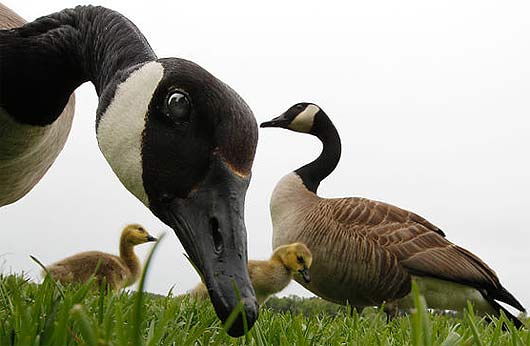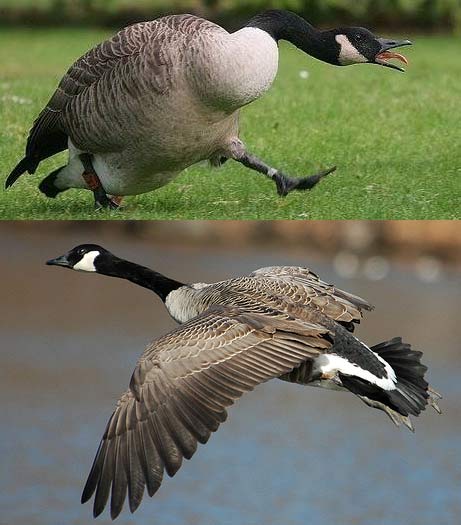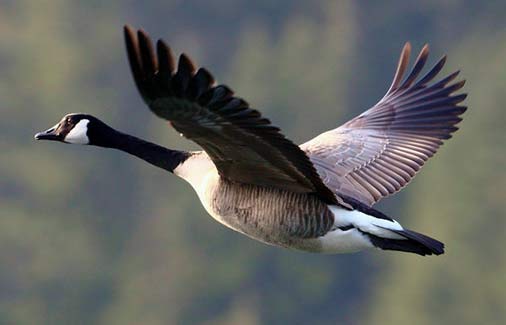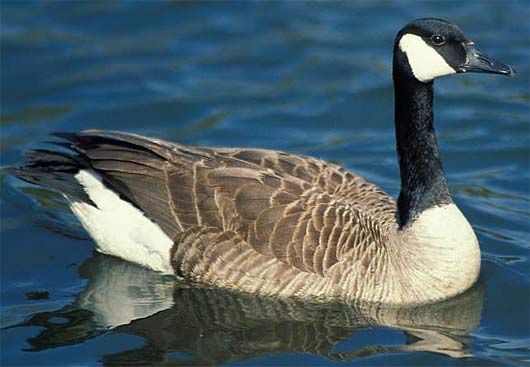Canada Goose – Plucky Honker

When you hear the “honking” of migrating Canada geese in North America you know that signals the changing seasons of fall and spring. A glance skyward on a frosty morning might reveal the characteristic V-shaped migratory flight formation. Within the flock are subunits consisting of family groups. A male-female pair mates for life and the family stays together until the next breeding season. The bonds of the family are strong and are constantly reinforced by social ceremonies. A bird will look for a new mate, however, if its partner dies. Sometimes a family will separate in their travels but often they will later reunite. The geese are known for being a bit “plucky” or “onery”.
The Canada goose has the most species variation of all North American waterfowl. Eleven subspecies or races are recognized, which vary in size from the giant (11 to 13 lbs or even up to 20 lbs (9 kg)) to the smaller cackling goose (only 2.8 to 3.4 lbs). Each subspecies is in some way adapted to its specific habitat. The smaller subspecies migrate farthest north to breed. Then they fly further trajectories over the larger birds in fall to winter farther to the south.

Like other geese, the male Canada goose assists his mate rearing the young. The female incubates the 4 to 7 egg clutch and rarely leaves the vicinity of the nest during the 24 to 28 days of incubation. The male stands guard nearby. The male and female have the same coloring: the dark head and neck with white cheek patches; brownish upper breast, flanks, and back; and white or gray underparts. A human observer finds difficulty in distinguishing the members of the pair.
Pairs usually are formed at two years of age, but first nesting usually occurs at three years. The nesting territory of a pair consists of the nest site and environs, defended from other pairs by threat and display, or rarely by combat. Canada geese will nest just about anywhere: on the ground, on islands, in cliffside caves, in hawk nests in trees, in washtubs fastened high in trees, or on artificial platforms in marshes. Elevated locations are preferred. Hatching success is higher in elevated nests because this puts them out of the reach of predators.

Young geese and others that may not mate the breeding year, fly far to the north in spring to molt and spend the summer. Various lakes in the Northwest Territories of Canada are the gathering grounds for great flocks of non-breeding Canada geese. Why these birds fly thousands of miles north to replace their old feathers is a mystery. One theory is that by removing themselves from breeding marshes, they avoid food competition with the others that are breeding. Maybe they just enjoy unencumbered travel so they go a little further.
The Canada goose has adapted well to changes in the landscape that have accompanied settlement. Crop residues now supply winter food for many noisy honkers and water reservoirs and refuges serve as safe loafing grounds. The birds are adept at gleaning corn, wheat, milo, rice, or other grains left on the ground after harvest. They are equally comfortable grazing on winter wheat, alfalfa, or other greens. Like the mallard, pintail, and wigeon, the Canada goose shows the adaptability necessary to thrive in a changing world. The geese have also found territories in Europe and been introduced (or arrived somehow) to Asia and New Zealand.

